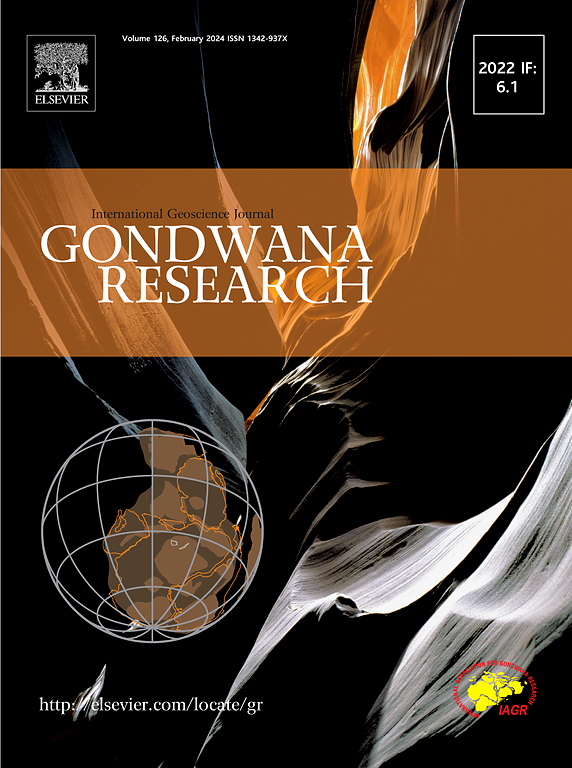阿拉伯-努比亚盾的构造改造:埃及Meatiq片麻岩穹窿发掘的结构记录分析
IF 7.2
1区 地球科学
Q1 GEOSCIENCES, MULTIDISCIPLINARY
引用次数: 0
摘要
东非造山带北段的构造是一个有争议的问题。在阿拉伯努比亚地盾(ANS)中发现的晚造山扳手构造的广泛活动,肢解和掩盖了增生和碰撞记录。我们研究了Meatiq片麻岩圆顶(MGD),位于埃及中部东部沙漠(CED, Egypt),这里是挤压、伸展和透流构造交汇的地方。确定了三个构造域:Meatiq Dome (MDSZ)、Murr (MSZ)和Atalla (ASZ)剪切带。本文对糜棱岩进行了中子衍射定量织构分析,探讨了糜棱岩在不同构造水平上的变形条件,为糜棱岩的演化提供了新的证据,并讨论了糜棱岩的区域意义。结果表明,MGD是一个单独的与断层相关的片麻岩穹丘,由一个具有~ NW-SE运动学(MDSZ)的主要伸展分离所包围。结构记录显示750°~ 350°C变形条件下的构造剥蚀作用,与620 ~ 580 Ma的快速等温发掘相一致,现有年龄和变质数据支持。野外调查表明,北西-东南向的伸长几何形状与伸展活动无关,而具有同时期的NE-SW缩短成分。大的扳手剪切区(MSZ和ASZ)延续了这种结构,并在低温度条件下(<400°C)适应变形应变。考虑到MDSZ的活动与晚新元古代冈瓦纳超大陆形成的主要碰撞阶段是同时代的,我们假设Meatiq片麻岩丘的挖掘是一次由重力不稳定性引发的同步碰撞崩塌的结果,并受到同期收缩的调节,与晚期走滑构造(如Najd断裂系统)没有遗传关系。MGD构造-热演化表明,该EAO段岩石圈经历了复杂的构造改造,其中MDSZ等大尺度边界发挥了重要的流变作用。本文章由计算机程序翻译,如有差异,请以英文原文为准。

Tectonic reworking in the Arabian-Nubian Shield: An analysis of the textural record of the exhumation of the Meatiq Gneiss dome (Egypt)
The construction of the northern section of the East Africa Orogen (EAO) is a subject of debate. The extensive activity of late orogenic wrench tectonics, recognized in the Arabian Nubian Shield (ANS), dismembered and obscured the accretionary and collisional record. We have investigated the Meatiq Gneiss dome (MGD), in the Central Eastern Desert (CED, Egypt) where compressional, extensional and transcurrent structures converge. Three structural domains have been identified: Meatiq Dome (MDSZ), Murr (MSZ) and Atalla (ASZ) shear zones. We have conducted neutron diffraction quantitative texture analysis on mylonites, to investigate deformation conditions at different structural levels of the MGD and provide new evidence on its evolution and discuss regional implications for the CED. Results indicate that the MGD is an individual fault-related gneiss dome, bounded by a major extensional detachment with ∼ NW-SE kinematics (MDSZ). Textural record documents tectonic denudation under deformation conditions from 750° to 350 °C, compatible with a fast isothermal exhumation from 620-580 Ma, as supported by existing age and metamorphic data. Field investigation suggest that the NW-SE elongated geometry of the dome is not related to the extensional activity, but with a coeval NE-SW shortening component. Large wrench shear zones (MSZ and ASZ) postdate this architecture and accommodate transpressional strain under low T conditions (<400 °C). Given that the activity of the MDSZ was contemporary with the main collisional phase of the formation of the Gondwana supercontinent in the Late Neoproterozoic, is postulated that the Meatiq Gneiss Dome exhumation was the result of a syn-collisional collapse, which was triggered by gravitational instabilities, and modulated by coeval contraction, without a genetic relation with late strike-slip tectonics (e.g., Najd fault system). MGD tectonothermal evolution indicates that the lithosphere of this EAO segment has followed a complex tectonic reworking where large-scale boundaries like the MDSZ and played a significant rheological role.
求助全文
通过发布文献求助,成功后即可免费获取论文全文。
去求助
来源期刊

Gondwana Research
地学-地球科学综合
CiteScore
12.90
自引率
6.60%
发文量
298
审稿时长
65 days
期刊介绍:
Gondwana Research (GR) is an International Journal aimed to promote high quality research publications on all topics related to solid Earth, particularly with reference to the origin and evolution of continents, continental assemblies and their resources. GR is an "all earth science" journal with no restrictions on geological time, terrane or theme and covers a wide spectrum of topics in geosciences such as geology, geomorphology, palaeontology, structure, petrology, geochemistry, stable isotopes, geochronology, economic geology, exploration geology, engineering geology, geophysics, and environmental geology among other themes, and provides an appropriate forum to integrate studies from different disciplines and different terrains. In addition to regular articles and thematic issues, the journal invites high profile state-of-the-art reviews on thrust area topics for its column, ''GR FOCUS''. Focus articles include short biographies and photographs of the authors. Short articles (within ten printed pages) for rapid publication reporting important discoveries or innovative models of global interest will be considered under the category ''GR LETTERS''.
 求助内容:
求助内容: 应助结果提醒方式:
应助结果提醒方式:


